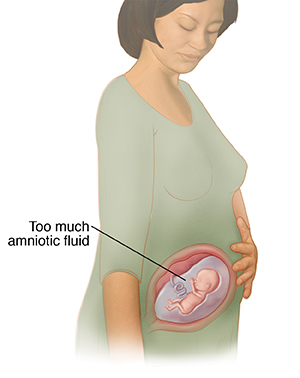Polyhydramnios
Amniotic fluid surrounds your unborn baby and protects it as it grows. It also helps the baby’s muscles, lungs, and digestive tract develop the right way. Your healthcare provider has found that you have too much amniotic fluid in your uterus. This is called polyhydramnios. The problem is often easily managed.

Causes of polyhydramnios
Polyhydramnios may be more common in women with diabetes or certain other health problems. A health problem in the baby may also be a cause. But in more than 5 out of 10 cases, the cause of the high fluid levels is not known.
Diagnosing polyhydramnios
An ultrasound is done to measure the amount of amniotic fluid in the uterus. It uses sound waves to make detailed images of the inside of the uterus. During the test, the amount of amniotic fluid is measured. Most often this is done using a method called amniotic fluid index (AFI).
Managing polyhydramnios
Polyhydramnios often doesn't go away on its own. Your healthcare provider will do regular ultrasounds to watch your amniotic fluid level. Regular prenatal care is also done to check your baby's health. In many cases, no treatment is needed. If your provider decides that treatment is needed, it may include:
-
Medicines. These help reduce the amount of fluid being made. They are rarely used beyond 32 weeks.
-
Amnioreduction. This drains excess fluid from the uterus. It is done during amniocentesis.
-
Induction of labor. This may be done if the pregnancy is at term or beyond. Your healthcare provider will tell you more, if needed.
Follow-up care
If you or your baby has a health problem that has caused the high amniotic fluid level, the problem will be treated. Sometimes an issue affecting the baby can't be treated until after birth. Your healthcare provider can tell you more about the cause of your high amniotic fluid level. They can also talk with you about any needed treatments.
Call your healthcare provider
Call your healthcare provider right away if you have any of these:
-
Fever of 100.4°F (38°C) or higher, or as directed by your provider
-
Sudden or severe belly cramping
-
Fluid leaking from the vagina
-
Regular, rhythmic contractions
-
Baby moving less than normal